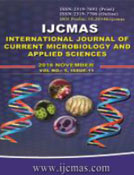


 National Academy of Agricultural Sciences (NAAS)
National Academy of Agricultural Sciences (NAAS)

|
PRINT ISSN : 2319-7692
Online ISSN : 2319-7706 Issues : 12 per year Publisher : Excellent Publishers Email : editorijcmas@gmail.com / submit@ijcmas.com Editor-in-chief: Dr.M.Prakash Index Copernicus ICV 2018: 95.39 NAAS RATING 2020: 5.38 |
Environmental pollution with toxic metals is a quickly growing serious problem for humanity and also a major threat to our planet. The problems effecting the environment are diverse and approaches to find solutions are often intimately connected with modern or classical methods of biotechnology. In this connection unique ability of microorganism especially cyanobacteria to tolerate and accumulate metal toxicity from the environment have made them an active research subject in the past few years. With this aim the present study is an attempt to investigate the effect of selenium on rice field cyanobacterium Hapalosiphon sp., when selenium(Se) reach to the rice field ecosystems through the sources of irrigation by simulating a similar situation in the laboratory. This paper discusses the role of alginate with which the algal cells have been immobilized and oxalic acid in reducing selenium toxicity in Hapalosiphon. The study revealed that the cell immobilization with Calcium alginate could protect the growth and nitrate reductase (NR) activity of the organism as compared to free cells against the toxicity of selenium at 200ppm (LC-50). Use of oxalic acid as a chelator greatly reduced the toxicity of selenium in the culture, improved growth and NR activity as compared to the controls. As naturally immobilized consortiums of cyanobacteria are a common occurrence in rice fields. This study indicates that presence of high concentrations of Se in these ecosystems may not have an adverse effect on the algal growth and enzyme activities as well as the rice plants.
 |
 |
 |
 |
 |